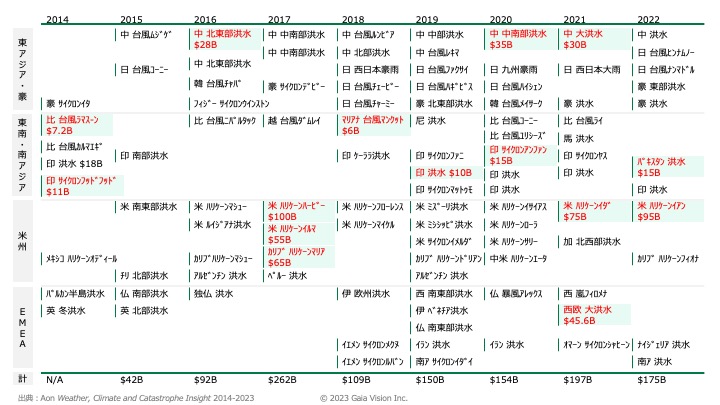Column
2023年07月23日
Highlights of global flood damage in the last 10 years
In early July 2023, a linear precipitation zone caused floods and other disasters in northern Kyushu. In mid-July, an active seasonal rain front caused severe damage in Akita. We would like to express our deepest sympathies to all those affected by the disasters and wish for the earliest restoration of the affected areas.
This article introduces floods and other events that have occurred in recent years not only in Japan but around the world. We hope that this overview analyzed by year and region will be a good reference for how countermeasures and planning/decisions should be designed in the future.
Global Flood Damages by Year and Region
The Weather, Climate & Catastrophe Insight Report published annually by Aon, a risk management consulting firm headquartered in the U.S., summarizes the most economically damaging events that occurred worldwide from 2014 to 2022 (in real USD). In addition to floods, windstorms such as typhoons, hurricanes, and cyclones are included. Events that caused particularly severe damage are highlighted in red.

Please also see the article summarizing natural disasters for the summer of 2022.
Global Flood Damage: East Asia, Australia, and Oceania
China, with its vast river basins such as the Yangtze and Yellow Rivers, which have historically experienced massive floods repeatedly, is becoming increasingly urbanized and experiencing frequent economically damaging events. Floods are mainly caused by heavy rains, and in the summer of 2020, 21 large floods hit central and southern China, the largest number since records began in 1996. The Three Gorges Dam, home to the world’s largest hydroelectric power plant in the middle reaches of the Yangtze River, was also reportedly the largest storage volume since its completion in 2009, killing 280 people and damaging 1.4 million homes and vast areas of farmland, causing economic damage of up to US$35 billion at the time.
In parallel with the construction and operation of dams and the introduction of monitoring technologies, China is also focusing on the ” Sponge City Concept,” which can be said to be one of the Nature-Based Solutions that are currently attracting high attention. In addition to paving roads and sidewalks with permeable pavement, introducing roadside greenery, and creating wetland parks (see photo below), cities are expanding with flood control functions that catch rainwater and let it slowly run off.

In Japan, torrential rains caused by linear precipitation zones and typhoons often occur, and heavy rains have repeatedly caused serious damage in various regions every year, including the Kanto/Tohoku torrential rains in 2015, the West Japan torrential rains in 2018, the East Japan typhoon in 2019, the July torrential rains in 2020, the August torrential rains in 2021, and Typhoon 14 (Nanmadol) in 2022. In February-March 2022, record-breaking rainfall was observed in eastern Australia, with more than a year’s worth of rainfall in a single week, resulting in the largest insured loss (US$4 billion) in the Australian insurance industry. The flooding in New Zealand is discussed in detail in this column.
Global Flood Damage: Southeast and South Asia
Together with East Asia, the region is strongly affected by the monsoon, and the rainy season is marked by frequent and severe typhoons, cyclones, and torrential rains that cause flooding. The Pakistan floods of 2022 are especially fresh in the memory, with precipitation nationwide from July to September exceeding the historical average by 175% and even locally by 450%.
Medical facilities were damaged by the floods, and many of the fatalities were reported to have died from acute malnutrition and waterborne diseases such as typhoid fever and malaria. Industry was also affected, with textile mills closing operation due to a shortage of cotton.
In recent years, Typhoon Rai (#22) in 2021 caused extensive damage with winds of 260 km/h, killing 400 people and causing the third largest economic damage in the Philippines (US$1 billion). Although the event is classified as a relatively small event in terms of monetary value, given the size of the country’s GDP and the fact that it is hit by an average of 20 typhoons per year, it is not difficult to imagine the magnitude of the impact and the difficulty of recovery.
Global Flood Damage: Americas
Hurricanes have caused significant damage in the Americas. In particular, Hurricane Harvey in 2017, with weak winds overhead that make tropical cyclones move, combined with the influence of a high-pressure system to the north, stalled in Texas for several days and recorded an astounding amount of precipitation totaling over 1,220 mm. In addition to flooding damage, the storms, which reached speeds of up to 215 km/h, caused extensive damage to buildings and lifelines such as electricity and water, resulting in economic damage totaling US$100 billion in the United States.
In September 2022, Hurricane Ian caused severe flood damage due to a devastating storm surge of 4.3 meters due to various factors, including the entry path from the west side of Florida and the topography of the coastline.
The typical path of a hurricane is to originate in the Caribbean, Gulf of Mexico, or near the Mid-Atlantic region, then move westward, proceeding northwest to north or further north to northeast. For example, in 2017, Hurricane Maria caused US$65 billion in economic damage to the Dominican Republic and Puerto Rico, and hurricanes are frequently causing damage in the Caribbean and Central America.
Global Flood Damage: EMEA (Europe, Middle East and Africa)
The EMEA region has a smaller impact of flood events compared to other regions of the world, for example, it is considered the fourth disaster type after drought, convective storms, and wind storms in terms of economic damage in 2022 (7.3% of the total amount). On the other hand, in July 2021, torrential rains caused by a stagnant low-pressure system in Germany, Belgium, and the Netherlands caused US$45.6 billion in severe flood damage. These floods have stimulated research and debate in Europe on the possibility of more intense and frequent flooding due to climate change.
In May 2023, there was another major flood in northern Italy that caused extensive damage to citizens and companies.
Future Measures for Floods
In general, the frequency of windstorm events such as floods and the economic damage they cause are becoming more frequent and larger around the world, with tropical cyclones and floods being the top two disasters in terms of annual average economic damage during 2000-2021, at US$86 billion/year and US$70 billion/year, respectively, ahead of droughts, earthquakes, and other disasters. (Although the contribution of higher precision and coverage of data and inflation should also be kept in mind,) the combination of socioeconomic factors such as population and GDP growth and their geographic distribution as well as climate change make large-scale economic damage events more likely, and many communities, households, and businesses may not be able to keep up with adequate flood prevention measures.
Now that future flood forecasts can be collected, it is increasingly important and required to overlay the potential flood damage on the picture of one’s assets and the networks (whether personal lifelines or corporate supply chains) on which they depend.
Reference) Click here to contact us for an individual consultation.
Gaia Vision is strong in assessing the physical risk of companies, especially flood risk. Our flood risk maps are a powerful tool for scenario analysis, with a very high resolution of 30 m in Japan and 90 m overseas, and the ability to calculate risk by scenarios, including 2°C and 4°C scenarios. Please consider using our services when starting a new scenario analysis or deepening your analysis in the future. If you have any questions, please feel free to contact us.
Sources
- Aon plc (2014-2023). Weather, Climate and Catastrophe Insight https://www.aon.com/weather-climate-catastrophe/index.aspx
- NASA Earth Observatory (30 October 2020). China’s Unrelenting Season of Flooding https://earthobservatory.nasa.gov/images/147471/chinas-unrelenting-season-of-flooding
- CNN (6 March 2022). Sydney faces more rain as death toll from Australian floods rises https://edition.cnn.com/2022/03/06/asia/sydney-australia-flood-intl-hnk/ index.html
- Hannes Goegele, WFP (17 October 2022). The Road to COP27: One Year After Typhoon Rai, Lessons Learned by the Philippines. https://ja.wfp.org/stories/road-cop-27-lessons-rai-philippines-one-year
- Tom Di Liberto, NOAA Climate.gov (18 September 2017). Reviewing Hurricane Harvey’s catastrophic rain and flooding. https://www.climate.gov/news-features/event-tracker/reviewing-hurricane- harveys-catastrophic-rain-and-flooding
- Matthew Seaver, WINK (28 March 2023). Why Hurricane Ian’s storm surge was so devastating https://news.yahoo.co.jp/byline/morisayaka/20220930-00317391
News
- 2025年04月03日 Our technology development project as a partner organization was selected for the “Overseas Demonstration of Satellite Data Application Systems (Feasibility Study),” a technology development theme for which the Space Strategic Fund is soliciting applications from the public.
- 2025年03月07日 ADRC (Asian Disaster Reduction Center) Researchers from Asian Countries Visited Our Company
- 2025年02月21日 ADRC (Asian Disaster Reduction Center) Researchers from Asian Countries Visited Our Company
- 2025年02月17日 ADRC (Asian Disaster Reduction Center) Researchers from Asian Countries Visited Our Company
- 2025年01月29日 Gaia Vision’s efforts for river flow simulation with Kyushu Electric Power Co. reported on the Nikkei news.
Column
-
-
-
-
-

